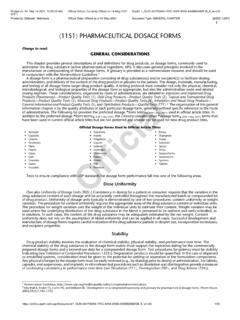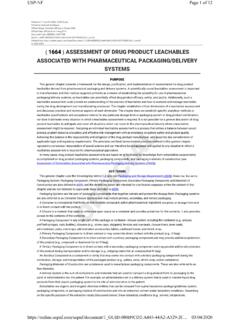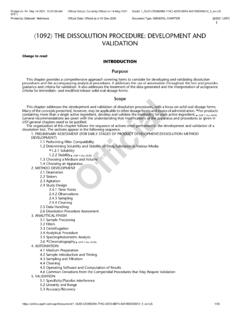Transcription of Qualification of Raw Materials Used in the Manufacturing ...
1 Qualification of Raw Materials used in the Manufacturing of Cellular TherapiesJim Richardson, Science and Standards Liaison, Global BiologicsLast Update: October 2019 Jim RichardsonCourse ID: BIO-QUAL-01 Challenges in raw material Qualification for cell therapy developers Background on raw Materials , definitions and regulatory expectations Qualification programs for raw Materials USP ancillary material standards Opportunities for standardization and future plansOutline2 2018 USP3 2019 USP Non-cGMP or research grade Materials used for production Materials available from single or limited number of suppliers Lot to lot variability in material quality/function Vendor testing insufficient to assure functionality Cell therapy products are generally not amenable to extensive purification, filtration, or terminal sterilization and therefore residuals are an issueChallenges in raw material Qualification for cell therapy developersOutline Challenges in raw material Qualification for cell therapy developers Background on raw Materials .
2 Definitions and regulatory expectations Qualification programs USP ancillary material standards Opportunities for standardization and future plans 5 2019 USP ICH Q7 Definition: Starting Materials , reagents, and solvents intended for use in the production of intermediates or APIs However, the term could cover Materials beyond this definition and as defined by examples listed in different regulatory guidance documents (For example starting or source Materials , in-process Materials ) Guidance from different regulatory bodies agrees on building strong pharmaceutical quality systems Raw Materials are not approved, however, their use is regulated under other mechanisms for regulation of biological medicines. Control of raw Materials is essential for maintaining safety, and to ensure lot to lot consistencyRaw Materials -regulations and definitions6 2019 USP Raw Materials may or may not remain in the final therapeutic product as active substances or as impurities Ancillary Materials are a subset of raw Materials .
3 Ancillary products may exert an effect on a therapeutic substance ( a cytokine may activate a population of cells ), but they are not intended to be in final formulation Some components are more critical than others. Risk assessment strategies are required to ensure quality A critical material will come in contact with cells with a potential to alter either the growth characteristics of the cells or the ability of the cell culture to meet lot release specificationsRaw or ancillary Materials 7 2019 USP The Code of Federal Regulations: 21 CFR 210 & 211: cGMP for Finished Pharmaceuticals, Subpart E Control of Components and Drug Product Containers and Closures Emphasis on procedures for: receipt, identification, storage, handling, sampling, testing, and approval or rejection; BUT No mention of Evaluation or Qualification FDA s Guidance for Industry -Quality Systems Approach to Pharmaceutical CGMP Regulations, 2006-FDA s current thinking on 21 CFR 210 and 211 recommends, under THE QUALITY SYSTEMS MODEL/ Manufacturing / Examine Inputs (any Materials into a final product) A robust quality system will ensure that all inputs to the Manufacturing process are reliable because quality controls will have been established for the receipt, production, storage, and use of all inputs The quality systems approach also calls for periodic auditing of suppliers based on risk assessment.
4 Some components are more critical than others! Risk assessment strategies are required to ensure quality Regulatory Guidance8 2019 USP ICH Q7 GMP for Active Pharmaceutical Ingredients [in addition to agreeing with 21 CFR 211] states that: Manufacturers of intermediates and/or APIs should have a system for evaluating the suppliers of critical Materials . Supplier approval should include an evaluationthat provides adequate evidence ( , past quality history) that the manufacturer can consistently provide material meeting analyses should be conducted on at least three batches before reducing in-house testing. ICH Q10 Pharmaceutical Quality System, states that The pharmaceutical company is ultimately responsible to ensure processes are in place to assure the control of outsourced activities and quality of purchased Materials . (a) Assessing prior to outsourcing operations or selecting material suppliers, the suitability and competence of the other party to carry out the activity or provide the material using a defined supply chain ( , audits, material evaluations, Qualification ), (d) Monitoring incoming ingredients and Materials to ensure they are from approved sources using the agreed supply Guidance (Cont d)9 2019 USP Annex 2 EU GMP Guidelines: Special consideration should be given to quality of the starting Materials , (.)
5 , culture media, cytokines, growth factors and otheradditional substances used in manufacture. ISO 9001:2008 The organization shall evaluate and select suppliers based on their ability to supply product in accordance with the organization s requirements. Criteria for selection, evaluation and re-evaluation shall be established. Quality by Design (QbD): A systematic approach to development that begins with predefined objectives and emphasizes product and process understanding and process control, based on sound science and quality risk managementRegulatory Guidance (Cont d)Outline Challenges In Raw material Qualification for Cell Therapy Developers Background on raw Materials , definitions and regulatory expectations Qualification programs USP ancillary material standards Opportunities for standardization and future plans11 2019 USP Science- based approach intended use of the raw material Level of risk ( Excipients, Raw Materials ) Direct vs, indirect contact with products Risk- based approaches as reflected in guidelines: ICHQ9, ICHQ3A, ICH Q7, and raw material assessment for Qualification of a biologics Understand the impact on the finished drug substance/product.
6 Approach to risk management: evaluate, reduce, balance, and communicate Qualification of Raw Materials12 2019 USP Reliance on Suppliers Specifications: lot to lot consistency and Materials for multiple use Compendial material Pharmacopeial procedures and which pharmacopeia Method verification ( USP <1226>) Non-compendial material : certificate of Analysis (CoA) Testing beyond the CoA Risk- based approaches and critical raw Materials Use of multi-supplier Materials Impact of Materials on final product (quality attributes, residuals) Define failure modes -use of quantitative tools-and mitigate risk Example: USP <1043> Ancillary Materials used in Cell Therapy Manufacturing Raw Materials : Practical Quality Approaches13 2019 USP Qualification programs for ancillary Materials will address: Lot-to-lot and vendor-to-vendor variability, traceability Impact on quality and safety of finished product Qualification programs <1043> Identification Selection Suitability for use Characterization Vendor Qualification QA/QC dataUSP <1043>: Ancillary Materials Qualification programsLevel of testing is based on the risk assessment profileUSP s Test Procedures can provide valuable tools14 2019 USPRisk- based Approach USP Chapter <1043> Revision in July 2017 and in 2019 Level of RiskCriteria that define the level of riskTier 1: Low riskIntended for use as licensed drugs, biologics or medical devices Suitability for use as a Manufacturing componentis required because the formulation, stability profile, and other quality aspects of these Materials may change once the material has been introduced in the Manufacturing 2: Low riskIntended to be used as ancillary Materials .
7 These Materials are well-characterized and produced under quality systems well-suited for biological Manufacturing , but the material is not a licensed medical product. Many are produced specifically for the manufacture of biological 3: Moderate riskThese are research-grade Materials not intended for use in biological Manufacturing ; sometimes approved by regulatory agencies as part of an in vitro diagnostic device. Tier 3 requires more Qualification than Tier 1 or Tier 2 4: High riskThese are Materials produced as industrial or research-grade Materials and may contain harmful impurities. They may also contain animal-or human-derived components with potential contaminants. This tier requires extensive Qualification before use as a component in biological product 2019 USP<1043> Ancillary Materials : Risk- based Qualification of AMs and Risk Reduction ActivitiesElements of Qualification and/or Risk Reduction ActivitiesTier 1 Tier 2 Tier 3 Tier 4 Master File cross reference XXXXC ertificate of analysisXXXXE valuationof lot-to-lot effect on process performanceXXXXR emoval from finished productXXXXS tability as stored and used in specific processXXXXC onfirmCertificate Analysis TestXXXV endor AuditXXXU pgrade Manufacturing to GMP levelXXDevelop internal specificationsXXLot tolot comparability may be neededXXTesting foradventitious agents may be neededXXTraceability to country of origin, safety from animal diseasesXAdventitious agent testing for animal source-relevant virusesXRisk.
8 LowHigh16 2019 USP Use of pharmaceutical grade raw material is preferred Traceability for human-and animal-derived Materials Supplier audit and Qualification to verify GMP claim Multiple suppliers preferred Challenge: Supplier, Packager, Secondary vendor/supplier. material meet compendialmonographs when possible Reference standards provide traceability to quality material Additional points to consider beyond quality of the material itself: Performance of raw material in culture system Lot-to-lot variability Interaction between raw material and cells Interaction between raw material and packaging Raw Materials Qualification Programs -Summary Outline Challenges In Raw material Qualification for Cell Therapy Developers Background on raw Materials , definitions and regulatory expectations Qualification programs USP ancillary material standards Opportunities for standardization and future plans18 2019 USPUSP s Ancillary material Standards<1043> Ancillary Materials (AMs) for Cell-, Gene-, and Tissue-Engineered ProductsSpecific AM Chapters<90> FBS Quality Attributes<130> Protein A<92> Cytokines and Growth Factors<89> Enzymes Reference Standards.
9 -FBS-Protein A-Interleukin-4-Trypsin-Collagenase I and IIGeneral Information Chapter Ancillary material Requirements for Specific AMsAncillary Materials Reference Standards19 2019 USP FBS Standard Requirements Osmolality: 280-360 mOsm/Kg Total Protein: 30-45 mg/mL pH: Endotoxin: Not more than 10 units/mL Hemoglobin level: Not more than 30 mg/dL Identification: Radial Immunodiffusion (RID): species ID, IgG levels Functionality Assays (Growth Curve and Clonal Assay) Associated Reference Standard (RS) Liquid frozen, 10 mL . The RS is a mixture of 3 lots, each contributed by a different manufacturer: Blend, filter-sterilize, freeze, irradiate, thaw, filter-sterilize, fill, freeze, and test Collaborative study included several laboratories to test: Identification (FBS sample positive for bovine IgG and content is < 500 mg/L) Growth curve (doubling time in test sample is not less than 90% compared to RS) <90> Fetal Bovine Serum (FBS)20 2019 USP Identification Meets requirements under Assay Retention time corresponds to the Standard solution as described in Purity Assay Ability to hydrolyze the peptide substrate Chromozym Trypsin Recombinant Porcine RS is used for system suitability (requirement: 90 -110% of the labeled value) Acceptance criteria: At least 180 Units/mg of protein using Chromozym as the substrate or at least 3800 USP Units/mg of protein using BAEE substrate.
10 Purity RP-HPLC Acceptance criteria: NLT 70% for the peak area of -Trypsin and NMT 20% for the peak area of -Trypsin.<89> Enzymes used as ancillary Materials in pharmaceutical 2019 USP This chapter covers recombinant human interleukin 4 (rhIL-4) Definition rhIL-4 is a single-chain polypeptide of 155 amino acids, expressed in Escherichia coli Contains NLT 107 USP Units of IL4/mg of total protein Identification Amino-terminal sequence analysis of at least eight amino acids Western Blot analysis to detect IL4 protein Assay Purity, SDS-PAGE with silver staining Protein Content, Concentration of IL4 determined by A280 measurement Specific tests Bioidentity, cell- based assay to determine the IL4 units/mg, Acceptance criteria: NLT 107 USP Units of IL4/mg Sterility Tests <71> Bacterial Endotoxin Test <85>USP <92> Growth factors and cytokines used in cell therapy manufacturingOutline Challenges In Raw material Qualification for Cell Therapy Developers Background on raw Materials , definitions and regulatory expectations Qualification programs USP ancillary material standards Opportunities for standardization and future plans23 2019 USP Which RMs are most critical to monitor and how?












